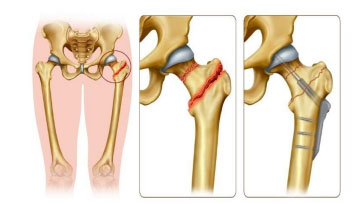Femoral neck stress fractures occur in two groups: young, active individuals and the elderly with osteoporosis. Femoral neck stress fractures are a common cause of hip pain for runners and military recruits due to chronic repetitive activity. This type of fracture is uncommon in the general population. Signs and symptoms are pain in the hip, groin, and front of the thigh; those who experience this condition may have a history of hip and groin pain related to an increased level of athletic activity. People who may have a femoral neck stress fracture will find it hard to train, compete, and walk, thus negatively impacting an athletic career.
The treatment plan will depend on the severity of the fracture. Compression fractures are considered stable and may be treated with several days of rest followed by a period of protected weight bearing. Therefore, no surgery is required. Even still, nonoperative treatment requires X-rays because of the potential for a possible late displacement, which is complicated to treat, and occurs most frequently in young adults. If the fracture continues to go undetected, or if left untreated, this type of stress fracture can lead to a complete fracture (displaced) from the femoral neck. The consequences can lead to serious complications, such as displacement and risk of osteonecrosis. These complications require secondary reconstructive surgery. After surgery, physical therapy will begin. The goal is to control and reduce pain, to improve and restore range of motion of the hip. Once the patient no longer complains of major pain, he or she will be able to tolerate weight-bearing walking, swimming, and cycling activities.
If you or anyone you know have these symptoms, please contact your primary care physician or general practitioner for a physical assessment and work-up.

References
Femoral Neck Stress Fracture. https://www.shutterstock.com/image-illustration/illustration-fracture-femur-bone-femoral-neck-1580834260.
Ilusmedical. (2020). [Illustration]. Illustration fracture femur bone, with fracture in the femoral neck and in the greater trochanter, correction of the fracture with fixation by screws and sliding plate.
Melanga, G. (2016). Femoral Neck Fracture. https://emedicine.medscape.com/article/86659-overview.
Wildstein, M. (2020). Femoral Neck Stress and Insufficiency Fractures.
https://emedicine.medscape.com/article/1246691-overview.
